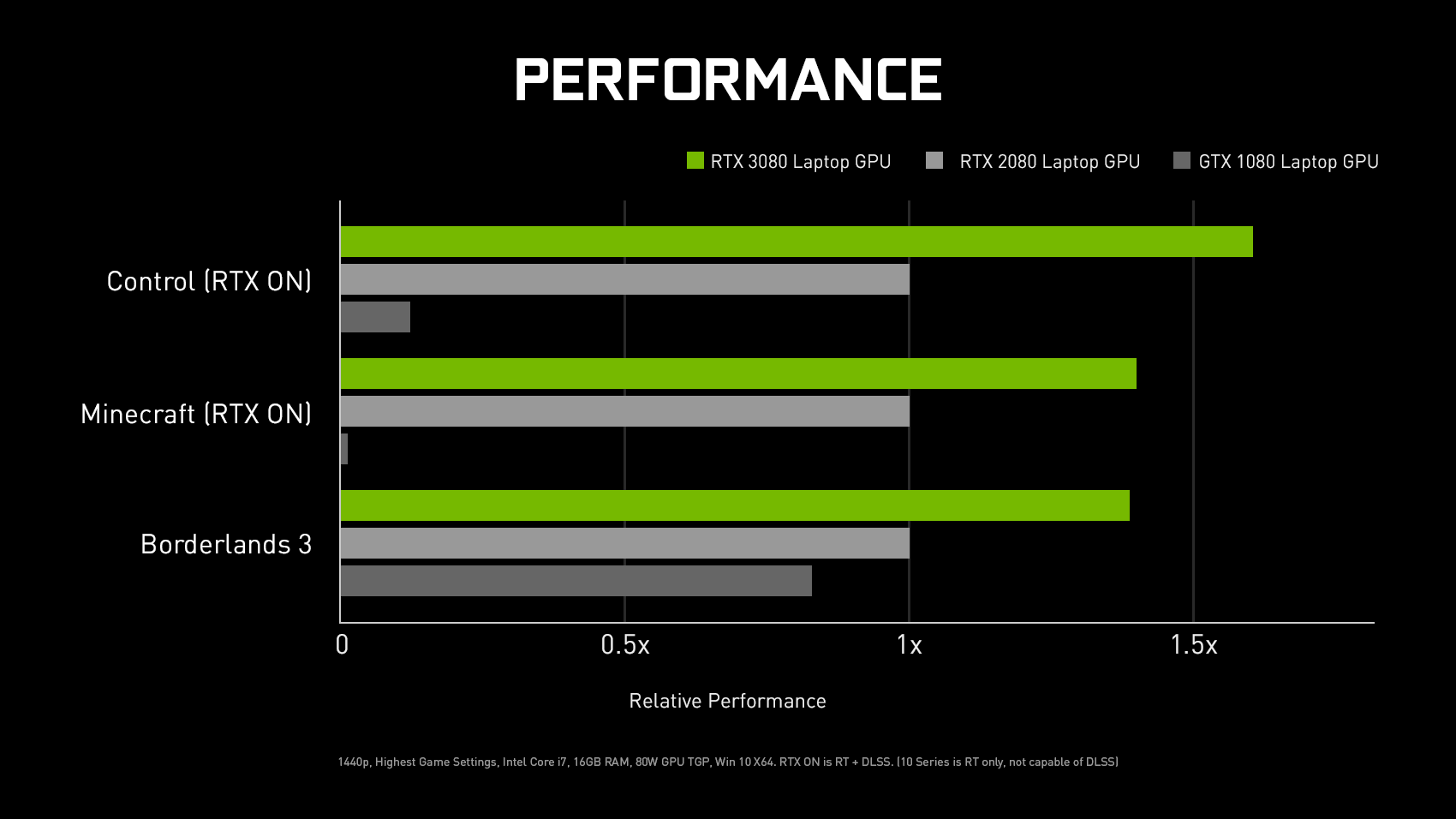New year means shiny tech, and NVIDIA‘s bringing it in the form of its Ampere tech, its 2nd gen RTX architecture making its way to laptops 26 January. GeForce RTX 30 Series Laptop GPUs increase efficiency by up to 2X, accelerate performance, and introduce new 3rd gen Max-Q Technologies, allowing gaming laptops to be the fastest they have ever been yet to deliver stunning ray-traced experiences in top gaming titles, as well as enabling content creators to produce incredible art pieces in hundreds of GPU-accelerated apps. With the recently concluded CES 2021, there must have been some of these laptops that’s caught your eye.
What is NVIDIA’s Ampere tech that’s powering the GeForce RTX GPUs and laptops though?
Featuring the NVIDIA Ampere Streaming Multiprocessors (SMs), the 2x FP32 throughput is capable of delivering vastly improved performance with improved performance per watt, as well as PCI Express 4.0 support and numerous other architectural enhancements.
The new 2nd Generation Ray Tracing Cores have up to 2x the throughput, enabling GeForce RTX gamers and content creators to enjoy high quality ray-traced effects, from Cyberpunk 2077 to Minecraft with RTX, and 3D rendering apps like Blender.
Assisting with that acceleration are new 3rd Generation Tensor Cores, with up to 2x the throughput of Turing-architecture Tensor Cores powering NVIDIA DLSS. That in turn accelerates performance in many titles like Control and Death Stranding, while generating beautiful, crisp game images that are often clearer and sharper than native resolution rendering with Temporal Anti-Aliasing.
The Tensor Cores have also enabled NVIDIA Broadcasting – for live streaming, video calls and voice chat – and NVIDIA Reflex – for more responsiveness in supported titles – the ever expanding GeForce Experience, NVIDIA Studio and so much more.

Third Gen Max-Q: Optimal Power and Performance
Max-Q is a system design approach that delivers high performance in thin and light gaming laptops. Thanks to this, laptops are now designed and built to ensure every component and element of the laptop – GPU, CPU, software, PCB design, power delivery, thermals – is optimized for power and performance.
The GeForce RTX 30 Series laptops is utilizing new third gen Max-Q Technologies for new system optimizations to deliver substantial improvements to efficiency, performance, battery life, and acoustics.
Dynamic Boost 2.0
In new laptops will be Dynamic Boost 2.0 which uses AI to balance power between the CPU, GPU and GPU memory. The AI system manages power on a per-frame basis so that your laptop constantly optimizes performance according to where power is needed the most.
Whether the application is loading the CPU, the GPU, or the GPU memory, the result is a larger performance boost than ever before. In a GPU-bound workload, like gaming or 3D rendering, the system can allocate up to 20W more to the GPU, automatically and seamlessly boosting frame rates or reducing rendering times.
Dynamic Boost 2.0 is available on all GeForce RTX 30 Series Max-Q laptops and is enabled out of the box, helping maximize performance in every app and game.

WhisperMode 2.0
WhisperMode 2.0 debuts on GeForce RTX 30 Series laptops for a new level of acoustic control for gaming laptops.
Reengineered from the ground up and custom-built into laptops at a system level, users can now choose a desired acoustic level, and WhisperMode 2.0’s AI-powered algorithms will do the rest, dynamically managing the CPU, GPU, game settings and fan speeds to deliver great acoustics and the best possible performance.

NVIDIA DLSS
Not forgetting NVIDIA DLSS, it’s now available in over 30 games with support coming to more games with many upcoming integrations in the works. DLSS accelerates performance by up to 60% in Cyberpunk 2077, and doubles the frame rate in Minecraft with RTX.
DLSS works by using AI and RTX Tensor Cores to deliver up to 2X the performance in the same power. Compare a regular GPU which needs to calculate almost 4 million pixels for a single 1440p frame to DLSS requiring only a fraction of the pixels, which improves efficiency and increases performance.
NVIDIA DLSS is also available in content creation apps, such as D5 Render, letting you visualize beautiful 3D environments in real time as you create them.
Resizeable BAR Support
The standardized PCI Express interface features a technology called “Resizable BAR”, which allows modern CPUs to access all GPU VRAM simultaneously, rather than the much smaller multiple requests of old. As the CPU and GPU are constantly swapping data, doing this in one big batch rather than multiple smaller ones can increase performance in certain games.
Resizable BAR improves performance without increasing power usage, helping increase efficiency and battery life, giving players more battery-powered game time. And when plugged in, it’ll help gamers achieve even higher frame rates.
GeForce RTX 30 Series laptops will support Resizable BAR via a driver release for laptops that implement it.

The Ultimate Play
The GeForce RTX 30 Series isn’t limited to just desktops, with laptops getting in on the action too. With award-winning NVIDIA Ampere architecture, 3rd Generation Ray Tracing Cores, 2nd Generation Tensor Cores, and streaming multiprocessors, you can get the most realistic ray-traced graphics and cutting-edge AI features anywhere, anytime.
New GeForce RTX 30 Series laptops with innovative 3rd gen Max-Q are able to maximize performance, efficiency, battery life and acoustics, to give you the best user experience possible.
Learn more about the tech behind NVIDIA here.










![[EXCLUSIVE] Inside Japan’s Indie Game Revolution – An Interview with BitSummit Organizer Masahiko Murakami](https://cdn.gamerbraves.com/2025/05/BitSummit-Orgainzer_Interview_FI-360x180.jpg)
![[EXCLUSIVE] The Art of Adaptation: Developer Interview Details the OVERLORD Mobile RPG Lord of Nazarick](https://cdn.gamerbraves.com/2025/05/Lord-of-Nazarick_Interview_FI-360x180.jpg)
![[EXCLUSIVE] Taking Gundam in Bold New Directions – Interview with GQuuuuuuX Director Kazuya Tsurumaki](https://cdn.gamerbraves.com/2025/04/Kazuya-Tsurumaki_Interview_FI-1-360x180.jpg)


![[SEA Exclusive] From Shadows to Shipwrecks – Jennifer English Talks About Bringing Emotional Depth to Clair Obscur: Expedition 33](https://cdn.gamerbraves.com/2025/04/Clair-Obscur-Jennifer-English_Interview_FI-360x180.jpg)

![[EXCLUSIVE] Do the Game Interview – An Intimate Look at the Challenges of Game Development](https://cdn.gamerbraves.com/2025/04/Do-the-Game_Interview_FI-1-360x180.jpg)
![[EXCLUSIVE] Interview with the Minds Behind of Den of Wolves – 10 Chambers’ New Sci-Fi Heist FPS](https://cdn.gamerbraves.com/2025/04/Den-of-Wolves_Interview_FI-360x180.jpg)










![[GUIDE] SD Gundam G Generation Eternal Unit Tier List](https://cdn.gamerbraves.com/2025/04/SD-Gundam-G-Generation-Eternal-Tier-List_Review_FI-360x180.jpg)